-
 Bitcoin
Bitcoin $106,754.6083
1.33% -
 Ethereum
Ethereum $2,625.8249
3.80% -
 Tether USDt
Tether USDt $1.0001
-0.03% -
 XRP
XRP $2.1891
1.67% -
 BNB
BNB $654.5220
0.66% -
 Solana
Solana $156.9428
7.28% -
 USDC
USDC $0.9998
0.00% -
 Dogecoin
Dogecoin $0.1780
1.14% -
 TRON
TRON $0.2706
-0.16% -
 Cardano
Cardano $0.6470
2.77% -
 Hyperliquid
Hyperliquid $44.6467
10.24% -
 Sui
Sui $3.1128
3.86% -
 Bitcoin Cash
Bitcoin Cash $455.7646
3.00% -
 Chainlink
Chainlink $13.6858
4.08% -
 UNUS SED LEO
UNUS SED LEO $9.2682
0.21% -
 Avalanche
Avalanche $19.7433
3.79% -
 Stellar
Stellar $0.2616
1.64% -
 Toncoin
Toncoin $3.0222
2.19% -
 Shiba Inu
Shiba Inu $0.0...01220
1.49% -
 Hedera
Hedera $0.1580
2.75% -
 Litecoin
Litecoin $87.4964
2.29% -
 Polkadot
Polkadot $3.8958
3.05% -
 Ethena USDe
Ethena USDe $1.0000
-0.04% -
 Monero
Monero $317.2263
0.26% -
 Bitget Token
Bitget Token $4.5985
1.68% -
 Dai
Dai $0.9999
0.00% -
 Pepe
Pepe $0.0...01140
2.44% -
 Uniswap
Uniswap $7.6065
5.29% -
 Pi
Pi $0.6042
-2.00% -
 Aave
Aave $289.6343
6.02%
What does it mean that the VHF indicator is flat but the trend does not continue?
When the VHF indicator is flat but price moves, it often signals short-lived momentum or market manipulation rather than a sustainable trend.
Jun 20, 2025 at 06:01 pm
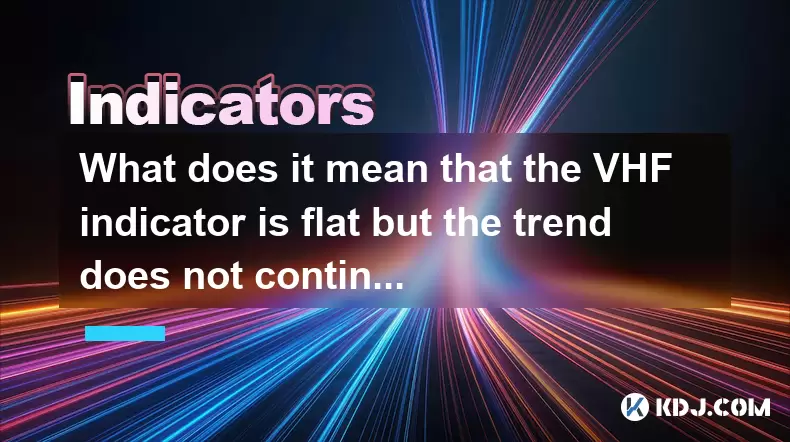
Understanding the VHF Indicator in Cryptocurrency Trading
The VHF indicator, or Vertical Horizontal Filter, is a technical analysis tool used by traders to determine whether an asset is in a trending or ranging phase. In the context of cryptocurrency trading, where market volatility is high and trends can shift rapidly, understanding the VHF indicator becomes essential for making informed decisions.
The VHF indicator calculates the ratio between the sum of absolute differences between consecutive highs and lows over a specific period and the highest high minus the lowest low over that same period. When the VHF value increases, it typically indicates a strong trend, either upward or downward. Conversely, when the VHF value decreases, it suggests that the market may be entering a consolidation or sideways movement.
However, there are instances when the VHF indicator appears flat, suggesting no clear trend, but the price action seems to move in one direction before reversing. This contradiction raises questions among traders: what does it mean when the VHF indicator is flat but the trend does not continue?
Why the VHF Indicator Might Be Flat During Apparent Trending Conditions
One explanation lies in how the VHF indicator interprets price data. A flat VHF line implies that the market isn’t forming a consistent directional bias. However, price might still exhibit short-term momentum that doesn't qualify as a sustained trend according to the VHF calculation.
This situation often occurs during short-lived rallies or sell-offs in cryptocurrencies. For instance, if Bitcoin experiences a sudden 10% move over two days due to news speculation but then reverses course, the VHF indicator may not register this as a valid trend because the movement lacks persistence. The VHF indicator emphasizes consistency over time rather than abrupt, volatile moves.
Another factor contributing to this phenomenon is market manipulation. In the crypto space, large holders (often referred to as "whales") can temporarily push prices up or down, creating the illusion of a trend. However, since these movements aren't supported by broader market sentiment or volume, the VHF indicator remains flat.
How to Interpret Price Action When VHF Is Flat But Price Moves
When observing a flat VHF indicator alongside apparent price movement, traders should consider multiple layers of analysis:
- Volume Analysis: If the price moves without a corresponding increase in volume, it's likely a false signal or temporary pump/dump activity.
- Candlestick Patterns: Look for reversal patterns such as shooting stars, engulfing candles, or hammer formations that could indicate a lack of continuation.
- Moving Averages: Overlay moving averages like the 50-day EMA or 200-day SMA to see if the price is respecting or breaking key levels despite the VHF indicator being flat.
Traders should also pay attention to support and resistance zones. Even with a flat VHF, if the price approaches a known resistance level and begins to reverse, it reinforces the idea that the trend lacks strength.
In addition, using complementary indicators like ADX (Average Directional Index) can provide clarity. While VHF focuses on trend presence, ADX measures trend strength. A rising ADX with a flat VHF could suggest that although a trend is emerging, it hasn't gained enough traction yet.
Practical Steps to Confirm Whether the Trend Will Continue
To avoid being misled by a flat VHF indicator and erratic price action, follow these steps:
- Check Multiple Timeframes: Analyze the same cryptocurrency pair across different timeframes (e.g., daily, 4-hour, 1-hour). If all timeframes show conflicting signals, it’s safer to stay out of the trade.
- Use Oscillators: Incorporate oscillators like RSI or MACD to detect divergence. If the price makes a new high but the oscillator doesn't confirm, it's a warning sign that the trend might not continue.
- Monitor On-Chain Metrics: Tools like Glassnode or CryptoQuant can reveal whether inflows to exchanges or miner behavior align with the current price movement.
- Observe Order Book Depth: Sudden spikes in order book depth followed by rapid liquidation may indicate fake breakouts or whale traps.
- Track News Sentiment: Use platforms like TheTIE or CoinGecko Market Movers to check if recent news supports the price movement or if it's just noise-driven.
These techniques help traders filter out false signals and make more confident decisions even when the VHF indicator is flat.
Common Misinterpretations of the VHF Indicator in Crypto Markets
Many traders misinterpret the VHF indicator as a direct trend-following tool. However, its primary function is to identify whether a trend is forming or whether the market is consolidating. It does not provide entry or exit signals on its own.
Another common mistake is relying solely on VHF values without cross-referencing other tools. Since crypto markets are highly speculative and influenced by external factors (regulatory news, macroeconomic shifts), the VHF indicator can lag behind real-time developments.
Some traders assume that a rising VHF always means a long opportunity, while a falling VHF signals a short. However, in reality, the VHF indicator doesn’t distinguish between bullish or bearish trends—it only identifies whether a trend exists at all.
Lastly, using default settings (usually 28 periods) for all cryptocurrencies can lead to inaccuracies. More volatile assets like altcoins may require shorter lookback periods, while major coins like Bitcoin or Ethereum may perform better with longer settings.
Strategies to Trade Around a Flat VHF Environment
If you're facing a flat VHF environment but notice price movement, consider the following strategies:
- Range Trading: Identify support and resistance levels and trade within the range. Use tight stop-losses and take profits based on historical volatility.
- Breakout Confirmation: Wait for a confirmed breakout above resistance or below support with increased volume before entering a position.
- Mean Reversion: Use overbought/oversold conditions from oscillators to anticipate pullbacks, especially after sharp moves that don’t align with the VHF indicator.
- News-Based Arbitrage: Monitor social media and crypto news outlets for sudden spikes in interest. Enter trades based on sentiment but keep risk exposure low.
- Hedging Positions: If you're already in a trade and the VHF indicator flattens, consider hedging your position using derivatives or stablecoins until clarity returns.
Each of these strategies acknowledges that the VHF indicator alone is not sufficient for decision-making and must be combined with broader market context.
Frequently Asked Questions
Q: Can I use the VHF indicator for day trading cryptocurrencies?
A: Yes, but with caution. The VHF indicator works best in conjunction with other tools like volume, candlestick patterns, and oscillators. Day traders should adjust the period setting to suit shorter timeframes and test strategies thoroughly before live trading.
Q: Does the VHF indicator work well with all types of cryptocurrencies?
A: Not necessarily. The VHF indicator performs better with major cryptocurrencies that have consistent volume and clearer trends. Altcoins with erratic price action may produce misleading signals unless additional filters are applied.
Q: How do I know if a trend is about to resume after a flat VHF reading?
A: Watch for volume surges, breaks above key resistance levels, and confirmation from leading indicators like MACD or RSI. Also, monitor on-chain metrics for signs of accumulation or distribution.
Q: Is the VHF indicator reliable during bear markets?
A: The VHF indicator remains functional during bear markets, but its interpretation must account for reduced liquidity and increased volatility. In prolonged downtrends, the VHF indicator may remain elevated even during weak rallies, so traders should use it cautiously and combine it with bear-market-specific strategies.
Disclaimer:info@kdj.com
The information provided is not trading advice. kdj.com does not assume any responsibility for any investments made based on the information provided in this article. Cryptocurrencies are highly volatile and it is highly recommended that you invest with caution after thorough research!
If you believe that the content used on this website infringes your copyright, please contact us immediately (info@kdj.com) and we will delete it promptly.
- Parataxis Holdings & Bridge Biotherapeutics: A Bitcoin Treasury Play in South Korea
- 2025-06-20 20:25:12
- Pi Network Price Prediction: Navigating June 2025's Uncertainties
- 2025-06-20 20:25:12
- AI Chip Maker Cerebras Hacked: Crypto Scam Alert!
- 2025-06-20 20:45:13
- dYdX Surge Program: Leveling Up DeFi Trading with Incentives
- 2025-06-20 20:45:13
- Bitcoin Breakout Watch: Can BTC Surge to $100K and Beyond?
- 2025-06-20 20:50:12
- Coinsilium, Bitcoin Treasury, Forza!: Riding the Crypto Wave in 2025
- 2025-06-20 20:50:12
Related knowledge

Is the golden cross of the ROC indicator below the zero axis effective?
Jun 20,2025 at 09:42pm
Understanding the ROC Indicator and Its Role in Cryptocurrency TradingThe Rate of Change (ROC) indicator is a momentum oscillator widely used by traders to assess the speed at which cryptocurrency prices are changing. It measures the percentage difference between the current price and the price from a certain number of periods ago. The ROC helps identif...
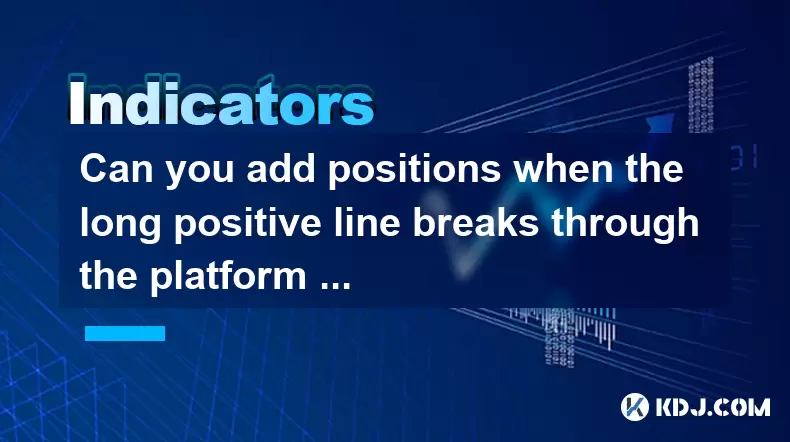
Can you add positions when the long positive line breaks through the platform and then shrinks and falls back?
Jun 20,2025 at 08:57pm
Understanding the Price Pattern: Breakthrough, Retract, and ConsolidationIn cryptocurrency trading, one of the commonly observed patterns involves a long positive line breaking through a consolidation platform, followed by a retraction or pullback. This scenario often raises questions among traders about whether to add positions after such a move. The p...
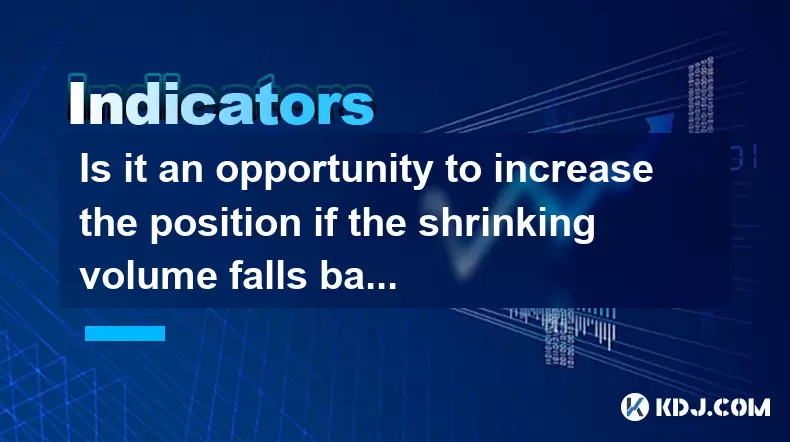
Is it an opportunity to increase the position if the shrinking volume falls back to the rising trend line?
Jun 20,2025 at 06:22pm
Understanding the Shrinking Volume in Cryptocurrency TradingIn cryptocurrency trading, volume is one of the most critical indicators used to confirm price movements and trends. When traders observe a scenario where volume shrinks during a pullback, it can signal either a lack of selling pressure or an imminent reversal. This phenomenon often occurs when...
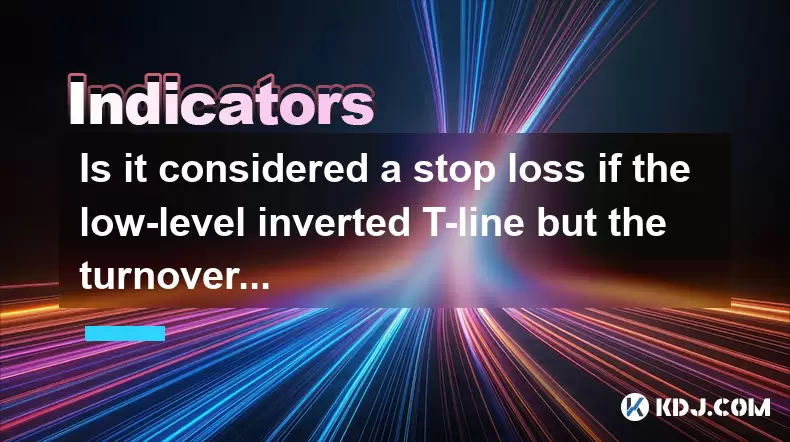
Is it considered a stop loss if the low-level inverted T-line but the turnover rate is extremely low?
Jun 20,2025 at 04:49pm
Understanding the Low-Level Inverted T-Line in Cryptocurrency ChartsIn technical analysis within the cryptocurrency market, candlestick patterns are crucial indicators for traders to predict potential price movements. The low-level inverted T-line is a specific type of candlestick pattern that often raises questions among traders. This pattern typically...
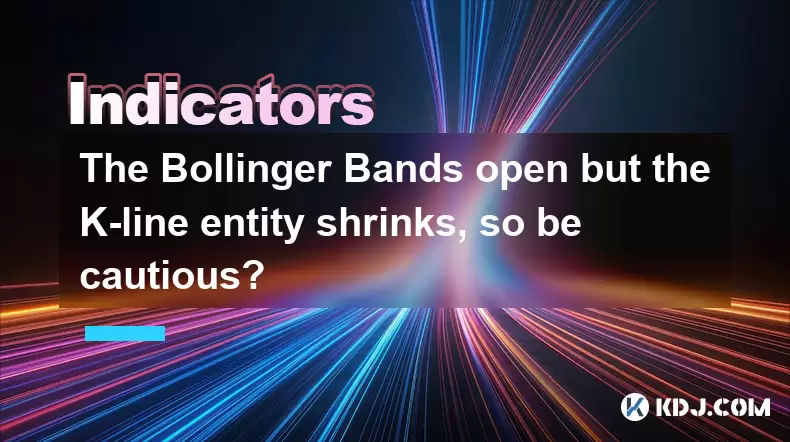
The Bollinger Bands open but the K-line entity shrinks, so be cautious?
Jun 20,2025 at 06:08pm
Understanding the Bollinger Bands and K-Line RelationshipBollinger Bands are a popular technical analysis tool used in cryptocurrency trading. They consist of a moving average (usually 20-period) with two standard deviation lines plotted above and below it. These bands dynamically adjust to price volatility, expanding when volatility increases and contr...
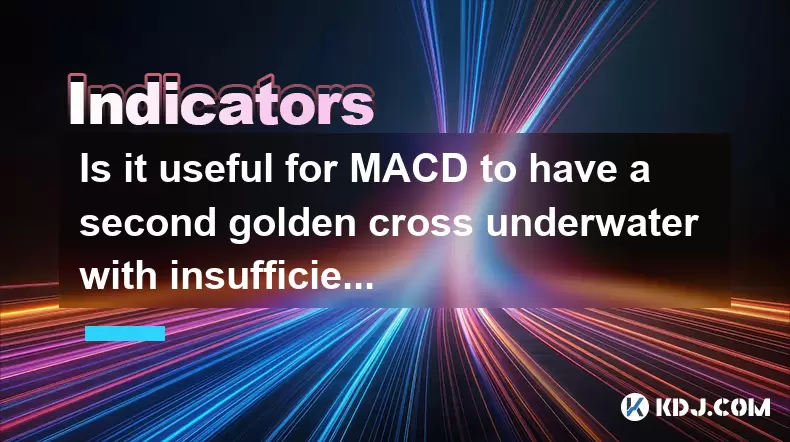
Is it useful for MACD to have a second golden cross underwater with insufficient volume?
Jun 20,2025 at 06:49pm
Understanding the MACD and Its Golden CrossThe Moving Average Convergence Divergence (MACD) is a popular technical analysis tool used by traders to identify potential buy or sell signals. It consists of three components: the MACD line, the signal line, and the histogram. The golden cross occurs when the MACD line crosses above the signal line, often see...

Is the golden cross of the ROC indicator below the zero axis effective?
Jun 20,2025 at 09:42pm
Understanding the ROC Indicator and Its Role in Cryptocurrency TradingThe Rate of Change (ROC) indicator is a momentum oscillator widely used by traders to assess the speed at which cryptocurrency prices are changing. It measures the percentage difference between the current price and the price from a certain number of periods ago. The ROC helps identif...

Can you add positions when the long positive line breaks through the platform and then shrinks and falls back?
Jun 20,2025 at 08:57pm
Understanding the Price Pattern: Breakthrough, Retract, and ConsolidationIn cryptocurrency trading, one of the commonly observed patterns involves a long positive line breaking through a consolidation platform, followed by a retraction or pullback. This scenario often raises questions among traders about whether to add positions after such a move. The p...

Is it an opportunity to increase the position if the shrinking volume falls back to the rising trend line?
Jun 20,2025 at 06:22pm
Understanding the Shrinking Volume in Cryptocurrency TradingIn cryptocurrency trading, volume is one of the most critical indicators used to confirm price movements and trends. When traders observe a scenario where volume shrinks during a pullback, it can signal either a lack of selling pressure or an imminent reversal. This phenomenon often occurs when...

Is it considered a stop loss if the low-level inverted T-line but the turnover rate is extremely low?
Jun 20,2025 at 04:49pm
Understanding the Low-Level Inverted T-Line in Cryptocurrency ChartsIn technical analysis within the cryptocurrency market, candlestick patterns are crucial indicators for traders to predict potential price movements. The low-level inverted T-line is a specific type of candlestick pattern that often raises questions among traders. This pattern typically...

The Bollinger Bands open but the K-line entity shrinks, so be cautious?
Jun 20,2025 at 06:08pm
Understanding the Bollinger Bands and K-Line RelationshipBollinger Bands are a popular technical analysis tool used in cryptocurrency trading. They consist of a moving average (usually 20-period) with two standard deviation lines plotted above and below it. These bands dynamically adjust to price volatility, expanding when volatility increases and contr...

Is it useful for MACD to have a second golden cross underwater with insufficient volume?
Jun 20,2025 at 06:49pm
Understanding the MACD and Its Golden CrossThe Moving Average Convergence Divergence (MACD) is a popular technical analysis tool used by traders to identify potential buy or sell signals. It consists of three components: the MACD line, the signal line, and the histogram. The golden cross occurs when the MACD line crosses above the signal line, often see...
See all articles

























































































